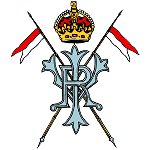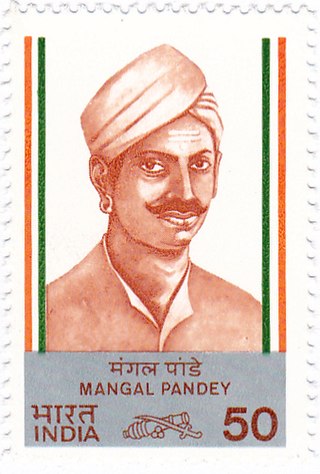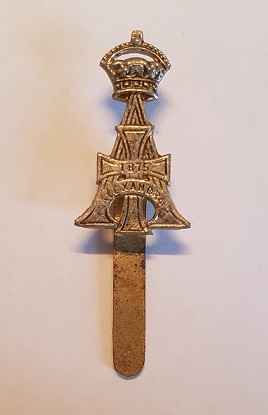
The Indian Rebellion of 1857 was a major uprising in India in 1857–58 against the rule of the British East India Company, which functioned as a sovereign power on behalf of the British Crown. The rebellion began on 10 May 1857 in the form of a mutiny of sepoys of the company's army in the garrison town of Meerut, 40 miles (64 km) northeast of Delhi. It then erupted into other mutinies and civilian rebellions chiefly in the upper Gangetic plain and central India, though incidents of revolt also occurred farther north and east. The rebellion posed a military threat to British power in that region, and was contained only with the rebels' defeat in Gwalior on 20 June 1858. On 1 November 1858, the British granted amnesty to all rebels not involved in murder, though they did not declare the hostilities to have formally ended until 8 July 1859.
The 102nd Regiment of Foot was a regiment of the British Army raised by the Honourable East India Company in 1742. It transferred to the command of the British Army in 1862. Under the Childers Reforms it amalgamated with the 103rd Regiment of Foot in 1881 to form the Royal Dublin Fusiliers.

The 21st Lancers (Empress of India's) was a cavalry regiment of the British Army, raised in 1858 and amalgamated with the 17th Lancers in 1922 to form the 17th/21st Lancers. Perhaps its most famous engagement was the Battle of Omdurman, where Winston Churchill (then an officer of the 4th Hussars), rode with the unit.

Mangal Pandey was an Indian soldier who played a key role in the events that led to the Indian Rebellion of 1857, which resulted in the dissolution of the East India Company and the beginning of the British Raj through the Government of India Act 1858. He was a sepoy in the 34th Regiment of the Bengal Native Infantry. In 1984, the Republic of India issued a postage stamp in his memory. His life and actions have also been portrayed in several Indian cinematic productions.
The Central India Campaign was one of the last series of actions in the Indian rebellion of 1857. The British Army and Bombay Army overcame a disunited collection of states in a single rapid campaign, although determined rebels continued a guerrilla campaign until the spring of 1859.

The 2nd Queen Victoria's Own Rajput Light Infantry, commonly shortened to 2nd Rajputs, was a regiment of the British Indian Army. Raised in 1798, it was amalgamated with five other Rajput regiments in 1922.
The White Mutiny was the unrest that occurred at the dissolution in 1858-59 of the "European Forces" of the East India Company in the aftermath of the Indian Rebellion of 1857.

The 19th Royal Hussars (Queen Alexandra's Own) was a cavalry regiment of the British Army, created in 1858. After serving in the First World War, it was amalgamated with the 15th The King's Hussars to form the 15th/19th The King's Royal Hussars in 1922.
The 5th Bengal European Cavalry was a cavalry regiment of the East India Company, created in 1858 and disbanded in 1859.
The 4th Bengal European Cavalry was a cavalry regiment of the British East India Company, created in 1858 and disbanded in 1859.
The 5th Bengal European Regiment was an infantry regiment of the British East India Company, created in 1858 and disbanded in 1860.
The 6th Bengal European Regiment was an infantry regiment of the British East India Company, created in 1858 and disbanded in 1867.
The 101st Regiment of Foot (Royal Bengal Fusiliers) was an infantry regiment of the Bengal Army and British Army that existed from 1652 to 1881. The regiment was raised in India in 1652 by the East India Company as the company's first non-native infantry regiment. Over the following two centuries, the regiment was involved in nearly all of the East India Company's conflicts which consolidated British rule over India. The Royal Bengal Fusiliers was transferred to the command of the British Army in 1862 following the Indian Mutiny of 1857 and the end of Company rule in India. Under the Childers Reforms it amalgamated with the 104th Regiment of Foot (Bengal Fusiliers) to form the Royal Munster Fusiliers in 1881.
The 104th Regiment of Foot was a regiment of the British Army, raised by the Honourable East India Company in 1765. Under the Childers Reforms it amalgamated with the 101st Regiment of Foot to form the Royal Munster Fusiliers.

The Bengal Army was the army of the Bengal Presidency, one of the three presidencies of British India within the British Empire.

The regiments of Bengal Native Infantry, alongside the regiments of Bengal European Infantry, were the regular infantry components of the East India Company's Bengal Army from the raising of the first Native battalion in 1757 to the passing into law of the Government of India Act 1858. At this latter point control of the East India Company's Bengal Presidency passed to the British Government. The first locally recruited battalion was raised by the East India Company in 1757 and by the start of 1857 there were 74 regiments of Bengal Native Infantry in the Bengal Army. Following the Mutiny the Presidency armies came under the direct control of the United Kingdom Government and there was a widespread reorganisation of the Bengal Army that saw the Bengal Native Infantry regiments reduced to 45.

The Madras Army was the army of the Presidency of Madras, one of the three presidencies of British India within the British Empire. The Madras Army was originally intended to be composed only of Rajputs, Mussalmans, and the three Telugu castes the Kammas, the Razus and the Velamas.
The 5th Light Infantry was an infantry regiment of the Bengal Army and later of the raj-period British Indian Army. It could trace its lineage back to 1803, when it was raised as the 2nd Battalion, 21st Bengal Native Infantry. The regiment was known by a number of different names: the 42nd Bengal Native Infantry 1824–1842, the 42nd Bengal Native (Light) Infantry 1842–1861, the 5th Bengal Native (Light) Infantry 1861–1885 and the 5th Bengal (Light) Infantry 1885–1903. Its final designation 5th Light Infantry was a result of the Kitchener Reforms of the Indian Army, when all the old presidency titles (Bengal) were removed. During World War I the regiment was stationed in Singapore and became notorious for its involvement in the 1915 Singapore Mutiny. The regiment was disbanded in 1922, after another set of reforms of the post World War I Indian Army.
The 17th Infantry (The Loyal Regiment) was an infantry regiment of the Bengal Army, later of the united British Indian Army. It was formed at Phillour in 1858 by Major J. C. Innes from men of the 3rd, 36th and 61st Bengal Native Infantry regiments who remained loyal to the British East India Company during the Indian Mutiny, and designated The Loyal Purbiah Regiment.

The siege of Arrah took place during the Indian Mutiny. It was the eight-day defence of a fortified outbuilding, occupied by a combination of 18 civilians and 50 members of the Bengal Military Police Battalion, against 2,500 to 3,000 mutinying Bengal Native Infantry sepoys from three regiments and an estimated 8,000 men from irregular forces commanded by Kunwar Singh, the local zamindar or chieftain who controlled the Jagdishpur estate.






